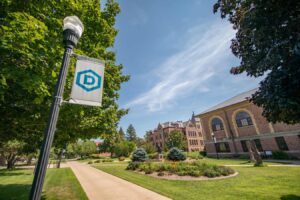Student Teaching – A Students Perspective

Senior year holds the promise of less stress for many students at DSU, with internships completed, the most challenging classes out of the way, and now-familiar professors and classmates around them as graduation comes in sight.
But for teaching majors in the College of Education, senior year may be the hardest, most challenging year of their four-year program. Instead of slowing down as graduation approaches, these students must draw on all of their energy, motivation, perseverance, and courage as they put their knowledge to the test in real time.
With initial observation practicums and more lengthy, hands-on practicums later on in the program, DSU’s teachers gain classroom experience throughout their program. However, student teaching is a far more immersive experience, requiring intensive lesson planning, full-day teaching, classroom management, grading, and interaction with parents.
For my major in English Education, student teaching for the Spring semester means full-time teaching four days a week, where I will be almost completely in charge of a 9th grade classroom after an initial two weeks of observation.
The opportunity to be mentored by a cooperating teacher, work closely with other teachers, and gain real-world experience with students in the classroom is rewarding on many levels. There is class that can compare with teaching to improve lesson planning, classroom management, and relationship-building skills.
However, there are also many challenges that come with this experience for DSU’s teachers. To receive a teaching degree in four years, the academic plan is designed so that students take multiple classes senior year at the same time as student teaching. Although these classes pair well with the knowledge they are gaining in student teaching, the workload is close to unbearable at times.
Because of the time and energy necessary to complete classes while teaching, DSU strongly encourages students not to work a job while they are fulfilling their student teaching credits. However, students must pay to student teach along with their other credits, which leads to financial strain if they do not work. Along with the usual college expenses of tuition and room and board, students need to pay for meals they can eat at the school they are teaching, as well as gas for any commute they may have; therefore, being expected not to devote time and energy to a job causes a lot of financial stress.
The final major challenge student teachers face is the requirement to follow the DSU academic calendar and the district calendar of the school where they are teaching simultaneously. For many student teachers, this means starting school the week before DSU is back in session after Christmas break. It also means that they are teaching full-time until the day before graduation, and every absence must be made up. If a student teacher is not able to make up all absences on their one free day a week, they must make them up after graduation.
Despite the challenges, DSU’s teachers are excited to gain experience in their field, spend time with kids and veteran teachers, and put their teaching skills to the test. As the need for teachers grows more and more pressing, I am hopeful that DSU and the state of South Dakota will make efforts to alleviate some of the obstacles, especially financial ones, for the teaching majors of the future.







